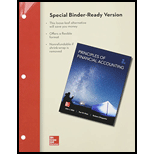
Prepare the
Explanation of Solution
Statement of cash flows: Statement of cash flows reports all the cash transactions which are responsible for inflow and outflow of cash and result of these transactions is reported as ending balance of cash at the end of reported period. Statement of cash flows includes the changes in cash balance due to operating, investing, and financing activities.
Cash flows from operating activities: Cash flows from operating activity represent the net cash flows from the general operation of the business by comparing the cash receipt and cash payments.
Direct method: The direct method uses the cash basis of accounting for the preparation of the statement of cash flows. It takes into account those revenues and expenses for which cash is either received or paid.
The below table shows the way of calculation of cash flows from operating activities using direct method:
| Cash flows from operating activities (Direct method) |
| Add: Cash receipts. |
| Cash receipt from customer |
| Less: Cash payments: |
| To supplier |
| Interest expense |
| For operating expenses |
| Income tax expenses |
| Net cash provided from or used by operating activities |
Table (1)
The cash flows from operating activities section for the year 2017:
| L Company | ||
| Statement of Cash Flows (partial)-Direct Method | ||
| For the Year Ended December 31, 2015 | ||
| Details | Amount ($) | Amount ($) |
| Cash flows from operating activities: | ||
| Receipts: | ||
| Collections from customers | 97,400 | |
| Total cash receipts | 97,400 | |
| Payments: | ||
| Cash payments to suppliers | (42,640) | |
| Cash payments for salaries | (17,820) | |
| Cash payments for rent | (9,040) | |
| Cash payments for insurance | (3,780) | |
| Cash payments for utilities | (2,740) | |
| Cash payments for interest | (3,600) | |
| Total cash payments | (79,620) | |
| Net cash provided by operating activities | $17,780 | |
Table (2)
Working notes:
The amount of cash receipts from customers.
Step 1: Calculate the change in accounts receivable.
Step 2: The Calculate the amount of cash receipts from customers.
Calculate the cash payments to suppliers.
Step 1: Calculate the change in inventory.
Step 2: Calculate the change in accounts payable.
Step 3: Calculate the amount of cash payments to suppliers.
Calculate the amount of cash paid for salaries expenses:
Step 1: Calculate the change in salaries payable.
Step 2: Calculate the amount of cash paid for income taxes.
Calculate the amount of cash paid for rent expenses:
Step 1: Calculate the change in prepaid rent.
Step 2: Calculate the amount of cash paid for rent expenses.
Calculate the amount of cash paid for insurance expenses:
Step 1: Calculate the change in prepaid insurance.
Step 2: Calculate the amount of cash paid for insurance expenses.
Calculate the amount of cash paid for utilities expenses:
Step 1: Calculate the change in utilities payable.
Step 2: Calculate the amount of cash paid for utilities expense.
Want to see more full solutions like this?
Chapter 16 Solutions
Principles of Financial Accounting, Chapters 1-17 - With Access (Looseleaf)
- what is the correct option ? general accounting question pls solve fastarrow_forwardNeptune Manufacturing assigns overhead costs to jobs on the basis of 140% of direct labor costs. The job cost sheet for Job 723 includes $32,600 in direct materials cost and $18,500 in direct labor cost. A total of 2,500 units were produced in Job 723. Required: a. What is the total manufacturing cost assigned to Job 723? b. What is the unit product cost for Job 723?arrow_forwardOn October 1, Year 6, Whitney Company declared a property dividend payable in the form of marketable equity securities classified as "trading" for financial accounting purposes. The marketable equity securities will be distributed to the common stockholders on December 1, Year 6. The investment in equity securities originally cost Whitney $510,000 on August 1, Year 6. The investment's fair value on various dates is as follows: October 1, Year 6 $530,000 December 1, Year 6 535,000 December 31, Year 6 540,000arrow_forward
- An item of equipment owned by Bruno Manufacturing cost $180,000 and had an estimated use of 90,000 hours. During the first 3 years, the equipment was used for 15,000, 19,000, and 12,000 hours. The equipment has an estimated life of 8 years and an estimated salvage value of $30,000. Required: Determine the depreciation for each of the 3 years using the units of production method.arrow_forwardAccountingarrow_forwardCan you explain this general accounting question using accurate calculation methods?arrow_forward

 AccountingAccountingISBN:9781337272094Author:WARREN, Carl S., Reeve, James M., Duchac, Jonathan E.Publisher:Cengage Learning,
AccountingAccountingISBN:9781337272094Author:WARREN, Carl S., Reeve, James M., Duchac, Jonathan E.Publisher:Cengage Learning, Accounting Information SystemsAccountingISBN:9781337619202Author:Hall, James A.Publisher:Cengage Learning,
Accounting Information SystemsAccountingISBN:9781337619202Author:Hall, James A.Publisher:Cengage Learning, Horngren's Cost Accounting: A Managerial Emphasis...AccountingISBN:9780134475585Author:Srikant M. Datar, Madhav V. RajanPublisher:PEARSON
Horngren's Cost Accounting: A Managerial Emphasis...AccountingISBN:9780134475585Author:Srikant M. Datar, Madhav V. RajanPublisher:PEARSON Intermediate AccountingAccountingISBN:9781259722660Author:J. David Spiceland, Mark W. Nelson, Wayne M ThomasPublisher:McGraw-Hill Education
Intermediate AccountingAccountingISBN:9781259722660Author:J. David Spiceland, Mark W. Nelson, Wayne M ThomasPublisher:McGraw-Hill Education Financial and Managerial AccountingAccountingISBN:9781259726705Author:John J Wild, Ken W. Shaw, Barbara Chiappetta Fundamental Accounting PrinciplesPublisher:McGraw-Hill Education
Financial and Managerial AccountingAccountingISBN:9781259726705Author:John J Wild, Ken W. Shaw, Barbara Chiappetta Fundamental Accounting PrinciplesPublisher:McGraw-Hill Education





